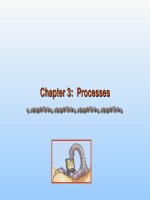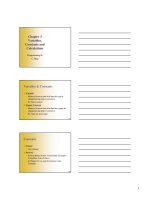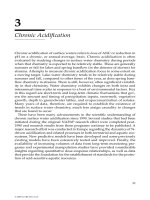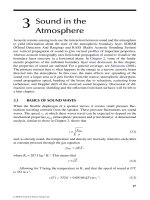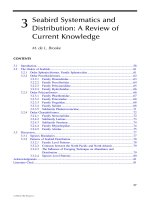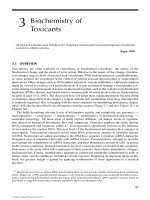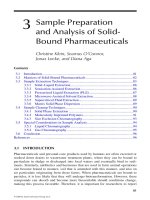Chapter 3- Sequential Logic Design Principles
Bạn đang xem bản rút gọn của tài liệu. Xem và tải ngay bản đầy đủ của tài liệu tại đây (73.5 KB, 7 trang )
184 Chapter 3 Digital Circuits
DO NOT COPY
DO NOT COPY
DO NOT COPY
DO NOT COPY
DO NOT COPY
DO NOT COPY
DO NOT COPY
DO NOT COPY
DO NOT COPY
Copyright © 1999 by John F. Wakerly Copying Prohibited
3.56 For each of the following resistive loads, determine whether the output drive
specifications of the 74LS00 over the commercial operating range are exceeded.
(Refer to Table 3-12, and use V
OLmax
= 0.5 V and V
CC
= 5.0 V.)
3.57 Compute the
LOW
-state and
HIGH
-state DC noise margins for each of the follow-
ing cases of a TTL output driving a TTL-compatible CMOS input, or vice versa.
3.58 Compute the maximum fanout for each of the following cases of a TTL-compat-
ible CMOS output driving multiple inputs in a TTL logic family. Also indicate
how much “excess” driving capability is available in the
LOW
or
HIGH
state for
each case.
3.59 For a given load capacitance and transition rate, which logic family in this chapter
has the lowest dynamic power dissipation?
Exercises
3.60 Design a CMOS circuit that has the functional behavior shown in Figure X3.60.
(Hint: Only six transistors are required.)
3.61 Design a CMOS circuit that has the functional behavior shown in Figure X3.61.
(Hint: Only six transistors are required.)
3.62 Draw a circuit diagram, function table, and logic symbol in the style of
Figure 3-19 for a CMOS gate with two inputs
A
and
B
and an output
Z
, where Z
= 1 if
A
= 0 and
B
= 1, and
Z
= 0 otherwise. (Hint: Only six transistors are
required.)
3.63 Draw a circuit diagram, function table, and logic symbol in the style of
Figure 3-19 for a CMOS gate with two inputs
A
and
B
and an output
Z
, where
(a) 470 Ω to V
CC
(b) 330 Ω to V
CC
and 470 Ω to GND
(c) 10 KΩ to GND (d) 390 Ω to V
CC
and 390 Ω to GND
(e) 600 Ω to V
CC
(f) 510 Ω to V
CC
and 510 Ω to GND
(g) 4.7 KΩ to GND (h) 220 Ω to V
CC
and 330 Ω to GND
(a) 74HCT driving 74LS (b) 74VHCT driving 74AS
(c) 74LS driving 74HCT (d) 74S driving 74VHCT
(a) 74HCT driving 74LS (b) 74HCT driving 74S
(c) 74VHCT driving 74AS (d) 74VHCT driving 74LS
A
B
C
Z
Figure X3.60
A
B
C
Z
Figure X3.61
Exercises 185
DO NOT COPY
DO NOT COPY
DO NOT COPY
DO NOT COPY
DO NOT COPY
DO NOT COPY
DO NOT COPY
DO NOT COPY
DO NOT COPY
Copyright © 1999 by John F. Wakerly Copying Prohibited
Z = 0 if
A
= 1 and
B
= 0, and
Z
= 1 otherwise. (Hint: Only six transistors are
needed.)
3.64 Draw a figure showing the logical structure of an 8-input CMOS
NOR
gate,
assuming that at most 4-input gate circuits are practical. Using your general
knowledge of CMOS electrical characteristics, select a circuit structure that min-
imizes the
NOR
gate’s propagation delay for a given area of silicon, and explain
why this is so.
3.65 The circuit designers of TTL-compatible CMOS families presumably could have
made the voltage drop across the “on” transistor under load in the
HIGH
state as
little as it is in the
LOW
state, simply by making the p-channel transistors bigger.
Why do you suppose they didn’t bother to do this?
3.66 How much current and power are “wasted” in Figure 3-32(b)?
3.67 Perform a detailed calculation of V
OUT
in Figures 3-34 and 3-33. (Hint: Create a
Thévenin equivalent for the CMOS inverter in each figure.)
3.68 Consider the dynamic behavior of a CMOS output driving a given capacitive
load. If the resistance of the charging path is double the resistance of the discharg-
ing path, is the rise time exactly twice the fall time? If not, what other factors
affect the transition times?
3.69 Analyze the fall time of the CMOS inverter output of Figure 3-37, assuming that
R
L
= 1 kΩ and V
L
= 2.5 V. Compare your answer with the results of Section 3.6.1
and explain.
3.70 Repeat Exercise 3.68 for rise time.
3.71 Assuming that the transistors in an FCT CMOS three-state buffer are perfect,
zero-delay on-off devices that switch at an input threshold of 1.5 V, determine the
value of t
PLZ
for the test circuit and waveforms in Figure 3-24. (Hint: You have
to determine the time using an RC time constant.) Explain the difference between
your result and the specifications in Table 3-3.
3.72 Repeat Exercise 3.70 for t
PHZ
.
3.73 Using the specifications in Table 3-6, estimate the “on” resistances of the p-chan-
nel and n-channel transistors in 74AC-series CMOS logic.
3.74 Create a 4×4×2×2 matrix of worst-case DC noise margins for the following
CMOS interfacing situations: an (HC, HCT, VHC, or VHCT) output driving an
(HC, HCT, VHC, or VHCT) input with a (CMOS, TTL) load in the (
LOW
,
HIGH
)
state; Figure X3.74 illustrates. (Hints: There are 64 different combinations to
examine, but many give identical results. Some combinations yield negative
margins.)
3.75 In the LED example in Section 3.7.5, a designer chose a resistor value of 300 Ω,
and found that the open-drain gate was able to maintain its output at 0.1 V while
driving the LED. How much current flows through the LED, and how much
power is dissipated by the pull-up resistor in this case?
3.76 Consider a CMOS 8-bit binary counter (Section 8.4) clocked at 16 MHz. For the
purposes of computing dynamic power dissipation, what is the transition frequen-
cy of least significant bit? Of the most significant bit? For the purposes of
186 Chapter 3 Digital Circuits
DO NOT COPY
DO NOT COPY
DO NOT COPY
DO NOT COPY
DO NOT COPY
DO NOT COPY
DO NOT COPY
DO NOT COPY
DO NOT COPY
Copyright © 1999 by John F. Wakerly Copying Prohibited
determining the dynamic power dissipation of the eight output bits, what frequen-
cy should be used?
3.77 Using only
AND
and
NOR
gates, draw a logic diagram for the logic function per-
formed by the circuit in Figure 3-55.
3.78 Calculate the approximate output voltage at
Z
in Figure 3-56, assuming that the
gates are HCT-series CMOS.
3.79 Redraw the circuit diagram of a CMOS 3-state buffer in Figure 3-48 using actual
transistors instead of
NAND
,
NOR
, and inverter symbols. Can you find a circuit
for the same function that requires a smaller total number of transistors? If so,
draw it.
3.80 Modify the CMOS 3-state buffer circuit in Figure 3-48 so that the output is in the
High-Z state when the enable input is
HIGH
. The modified circuit should require
no more transistors than the original.
3.81 Using information in Table 3-3, estimate how much current can flow through
each output pin when the outputs of two different 74FCT257Ts are fighting.
3.82 A computer system made by the Green PC Company had ten LED “status OK”
indicators, each of which was turned on by an open-collector output in the style
of Figure 3-52. However, in order to save a few cents, the logic designer connect-
ed the anodes of all ten LEDs together and replaced the ten, now parallel, 300-Ω
pull-up resistors with a single 30-Ω resistor. This worked fine in the lab, but a big
problem was found after volume shipments began. Explain.
3.83 Show that at a given power-supply voltage, an FCT-type I
CCD
specification can
be derived from an HCT/ACT-type C
PD
specification, and vice versa.
3.84 If both VZ and V_B in Figure 3-65(b) are 4.6 V, can we get V
C
= 5.2 V? Explain.
3.85 Modify the program in Table 3-10 to account for leakage current in the
OFF
state.
3.86 Assuming “ideal” conditions, what is the minimum voltage that will be recog-
nized as a
HIGH
in the TTL
NAND
gate in Figure 3-75 with one input
LOW
and
the other
HIGH
?
3.87 Assuming “ideal” conditions, what is the maximum voltage that will be recog-
nized as a
LOW
in the TTL
NAND
gate in Figure 3-75 with both inputs
HIGH
?
3.88 Find a commercial TTL part that can source 40 mA in the
HIGH
state. What is its
application?
HC HCT VHC VHCT
HC
HCT
VHC
VHCT
Output
Input
CL TL
CH TH
CL TL
CH TH
CL TL
CH TH
CL TL
CH TH
CL TL
CH TH
CL TL
CH TH
CL TL
CH TH
CL TL
CH TH
CL TL
CH TH
CL TL
CH TH
CL TL
CH TH
CL TL
CH TH
CL TL
CH TH
CL TL
CH TH
CL TL
CH TH
CL TL
CH TH
Key:
CL = CMOS load, LOW
CH = CMOS load, HIGH
TL = TTL load, LOW
TH = TTL load, HIGH
Figure X3.74
Exercises 187
DO NOT COPY
DO NOT COPY
DO NOT COPY
DO NOT COPY
DO NOT COPY
DO NOT COPY
DO NOT COPY
DO NOT COPY
DO NOT COPY
Copyright © 1999 by John F. Wakerly Copying Prohibited
3.89 What happens if you try to drive an LED with its cathode grounded and its anode
connected to a TTL totem-pole output, analogous to Figure 3-53 for CMOS?
3.90 What happens if you try to drive a 12-volt relay with a TTL totem-pole output?
3.91 Suppose that a single pull-up resistor to +5 V is used to provide a constant-1 logic
source to 15 different 74LS00 inputs. What is the maximum value of this resistor?
How much
HIGH
-state DC noise margin are you providing in this case?
3.92 The circuit in Figure X3.92 uses open-collector
NAND
gates to perform “wired
logic.” Write a truth table for output signal
F
and, if you’ve read Section 4.2, a
logic expression for
F
as a function of the circuit inputs.
3.93 What is the maximum allowable value for R1 in Figure X3.92? Assume that a 0.7
V
HIGH
-state noise margin is required. The 74LS01 has the specs shown in the
74LS column of Table 3-11, except that I
OHmax
is 100
µ
A, a leakage current that
flows into the output in the
HIGH
state.
3.94 A logic designer found a problem in a certain circuit’s function after the circuit
had been released to production and 1000 copies of it built. A portion of the cir-
cuit is shown in Figure X3.94 in black; all of the gates are 74LS00
NAND
gates.
The logic designer fixed the problem by adding the two diodes shown in color.
What do the diodes do? Describe both the logical effects of this change on the cir-
cuit’s function and the electrical effects on the circuit’s noise margins.
F
G
74LS01
74LS01
74LS01
W
X
Y
Z
+ 5.0 V
R1
R2
Figure X3.92
+5V
T
U
V
Z
Q
P
R
S
Y
X
Figure X3.94
188 Chapter 3 Digital Circuits
DO NOT COPY
DO NOT COPY
DO NOT COPY
DO NOT COPY
DO NOT COPY
DO NOT COPY
DO NOT COPY
DO NOT COPY
DO NOT COPY
Copyright © 1999 by John F. Wakerly Copying Prohibited
3.95 A Thévenin termination for an open-collector or three-state bus has the structure
shown in Figure X3.95(a). The idea is that, by selecting appropriate values of R1
and R2, a designer can obtain a circuit equivalent to the termination in (b) for any
desired values of V and R. The value of V determines the voltage on the bus when
no device is driving it, and the value of R is selected to match the characteristic
impedance of the bus for transmission-line purposes (Section 12.4). For each of
the following pairs of V and R, determine the required values of R1 and R2.
3.96 For each of the R1 and R2 pairs in Exercise 3.95, determine whether the termina-
tion can be properly driven by a three-state output in each of the following logic
families: 74LS, 74S, 74ACT. For proper operation, the family’s I
OL
and I
OH
specs
must not be exceeded when V
OL
= V
OLmax
and V
OH
= V
OHmin
, respectively.
3.97 Suppose that the output signal
F
in Figure 3.92 drives the inputs of two 74S04
inverters. Compute the minimum and maximum allowable values of R2, assum-
ing that a 0.7 V
HIGH
-state noise margin is required.
3.98 A 74LS125 is a buffer with a three-state output. When enabled, the output can
sink 24 mA in the
LOW
state and source 2.6 mA in the
HIGH
state. When dis-
abled, the output has a leakage current of ±20
µ
A (the sign depends on the output
voltage—plus if the output is pulled
HIGH
by other devices, minus if it’s
LOW
).
Suppose a system is designed with multiple modules connected to a bus, where
each module has a single 74LS125 to drive the bus, and one 74LS04 to receive
information on the bus. What is the maximum number of modules that can be
connected to the bus without exceeding the 74LS125’s specs?
3.99 Repeat Exercise 3.97, this time assuming that a single pull-up resistor is connect-
ed from the bus to +5 V to guarantee that the bus is
HIGH
when no device is
driving it. Calculate the maximum possible value of the pull-up resistor, and the
number of modules that can be connected to the bus.
3.100 Find the circuit design in a TTL data book for an actual three-state gate, and
explain how it works.
3.101 Using the graphs in a TTL data book, develop some rules of thumb for derating
the maximum propagation delay specification of LS-TTL under nonoptimal con-
ditions of power-supply voltage, temperature, and loading.
(a) V = 2.75, R = 148.5 (b) V = 2.7, R = 180
(c) V = 3.0, R = 130 (d) V = 2.5, R = 75
+5V
R1
R2
bus
(a)
Thevenin
termination
V
bus
(b)
Thevenin
equivalent of
termination
R
Figure X3.95
Exercises 189
DO NOT COPY
DO NOT COPY
DO NOT COPY
DO NOT COPY
DO NOT COPY
DO NOT COPY
DO NOT COPY
DO NOT COPY
DO NOT COPY
Copyright © 1999 by John F. Wakerly Copying Prohibited
3.102 Determine the total power dissipation of the circuit in Figure 3.102 as function of
transition frequency f for two realizations: (a) using 74LS gates; (b) using 74HC
gates. Assume that input capacitance is 3 pF for a TTL gate and 7 pF for a CMOS
gate, that a 74LS gate has an internal power dissipation capacitance of 20 pF, and
that there is an additional 20 pF of stray wiring capacitance in the circuit. Also
assume that the
X
,
Y
, and
Z
inputs are always
HIGH
, and that input
C
is driven with
a CMOS-level square wave with frequency f. Other information that you need for
this problem can be found in Tables 3-5 and 3-11. State any other assumptions
that you make. At what frequency does the TTL circuit dissipate less power than
the CMOS circuit?
3.103 It is possible to drive one or more 74AC or 74HC inputs reliably with a 74LS TTL
output by providing an external resistor to pull the TTL output all the way up to
V
CC
in the
HIGH
state. What are the design issues in choosing a value for this pull-
up resistor?
C
X
Y
Z
Figure X3.102
190 Chapter 3 Digital Circuits
DO NOT COPY
DO NOT COPY
DO NOT COPY
DO NOT COPY
DO NOT COPY
DO NOT COPY
DO NOT COPY
DO NOT COPY
DO NOT COPY
Copyright © 1999 by John F. Wakerly Copying Prohibited


